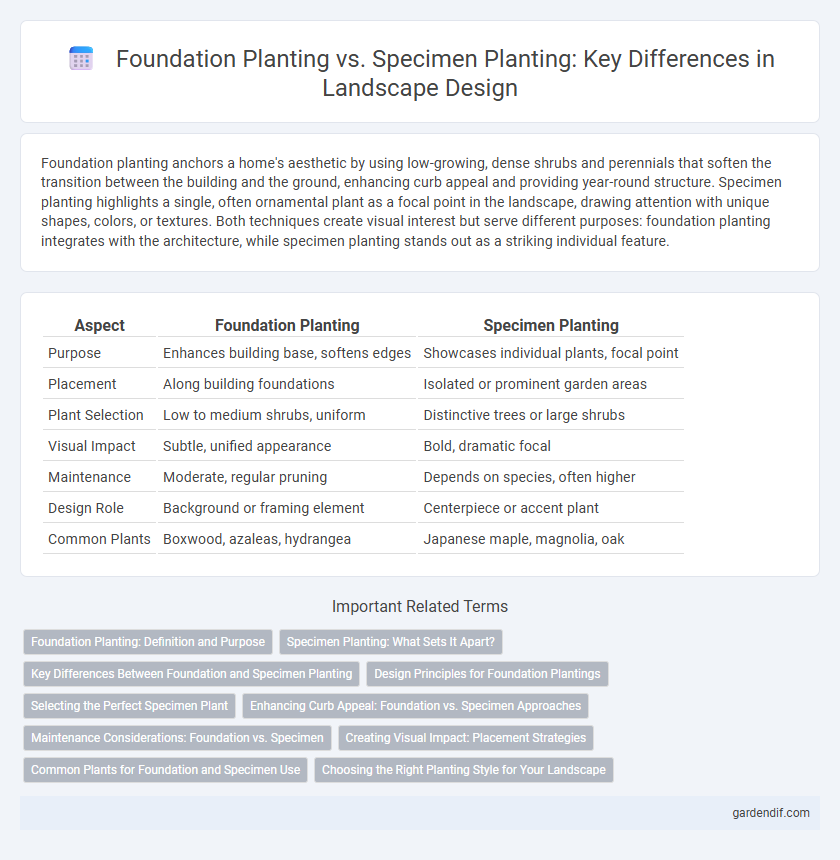
foundation planting vs specimen planting Illustration
Foundation planting anchors a home's aesthetic by using low-growing, dense shrubs and perennials that soften the transition between the building and the ground, enhancing curb appeal and providing year-round structure. Specimen planting highlights a single, often ornamental plant as a focal point in the landscape, drawing attention with unique shapes, colors, or textures. Both techniques create visual interest but serve different purposes: foundation planting integrates with the architecture, while specimen planting stands out as a striking individual feature.
Table of Comparison
| Aspect | Foundation Planting | Specimen Planting |
|---|---|---|
| Purpose | Enhances building base, softens edges | Showcases individual plants, focal point |
| Placement | Along building foundations | Isolated or prominent garden areas |
| Plant Selection | Low to medium shrubs, uniform | Distinctive trees or large shrubs |
| Visual Impact | Subtle, unified appearance | Bold, dramatic focal |
| Maintenance | Moderate, regular pruning | Depends on species, often higher |
| Design Role | Background or framing element | Centerpiece or accent plant |
| Common Plants | Boxwood, azaleas, hydrangea | Japanese maple, magnolia, oak |
Foundation Planting: Definition and Purpose
Foundation planting involves strategic placement of shrubs, flowers, and groundcovers around a building's base to enhance architectural features, provide insulation, and soften structural lines. This landscaping technique improves curb appeal, manages water runoff, and creates a welcoming transition between the building and surrounding environment. Proper foundation planting supports soil stability and reduces erosion, contributing to overall landscape health and sustainability.
Specimen Planting: What Sets It Apart?
Specimen planting emphasizes showcasing a single, standout plant as the focal point, unlike foundation planting which uses multiple plants to complement a building's base. This technique highlights unique species with distinctive shapes, colors, or textures, creating visual interest and architectural drama in the landscape design. Specimen plants often serve as artistic centerpieces, drawing attention and providing seasonal or year-round appeal.
Key Differences Between Foundation and Specimen Planting
Foundation planting emphasizes creating a cohesive base around a building using shrubs and low plants to enhance architectural features and provide year-round structure. Specimen planting highlights individual plants, often trees or unique shrubs, designed to serve as focal points due to their distinctive size, shape, or color. The key differences lie in their purpose: foundation planting supports and softens building lines, while specimen planting draws attention and creates visual interest independently within the landscape.
Design Principles for Foundation Plantings
Foundation plantings create a crucial transition between a building and its landscape by using low-maintenance shrubs and ground covers that emphasize architectural features and provide year-round visual stability. Specimen plantings, in contrast, serve as focal points designed to draw attention through unique shapes, colors, or textures, often positioned apart from structures. Effective design principles for foundation plantings include selecting plants with consistent growth habits, maintaining appropriate scale relative to the building, and ensuring seasonal interest to enhance curb appeal and architectural harmony.
Selecting the Perfect Specimen Plant
Selecting the perfect specimen plant involves evaluating its size, shape, and seasonal interest to create a focal point in the landscape. Specimen plants should have unique features such as striking foliage, vibrant flowers, or distinctive bark to stand out against foundation plantings. Planting them in visible, open spaces enhances their impact and contributes to the overall aesthetic balance of the garden design.
Enhancing Curb Appeal: Foundation vs. Specimen Approaches
Foundation planting uses shrubs and perennials along a building's base to create a cohesive, structured look that emphasizes architectural features and establishes visual balance. Specimen planting highlights a single, striking plant or tree as a focal point in the landscape, drawing attention through its unique form, color, or texture. Combining both approaches strategically enhances curb appeal by providing layered interest and depth, blending uniformity with standout features.
Maintenance Considerations: Foundation vs. Specimen
Foundation planting requires consistent pruning and regular watering to maintain its structured appearance and support the building's aesthetic, while specimen planting demands focused care on individual plants to ensure optimal growth and showcase unique features. Foundation plants often need pest control and seasonal adjustments to prevent overgrowth that can obscure architectural details, whereas specimen plants benefit from targeted fertilization and protection from environmental stressors. Both approaches require tailored maintenance strategies, but specimen planting involves more intensive care per plant compared to the broader, routine upkeep of foundation planting.
Creating Visual Impact: Placement Strategies
Foundation planting enhances a structure's framework by placing low to medium-height plants directly around the building's base, establishing a consistent and balanced visual foundation. Specimen planting places unique, eye-catching plants strategically throughout the landscape to draw attention and create focal points that elevate design interest. Combining these strategies ensures a cohesive composition while maximizing visual impact through contrast, scale, and placement.
Common Plants for Foundation and Specimen Use
Common plants for foundation planting include boxwood, hydrangea, and azalea, valued for their structured form and ability to soften building edges. Specimen planting often features standout species like Japanese maple, flowering dogwood, or crape myrtle, chosen for their unique shape, color, and visual impact. Selecting appropriate plants depends on landscape goals, growth habits, and maintenance requirements to ensure both foundation and specimen plants enhance overall design harmony.
Choosing the Right Planting Style for Your Landscape
Choosing the right planting style significantly impacts the overall aesthetic and functionality of your landscape. Foundation planting, placed near a structure's base, enhances architectural features and provides consistent greenery year-round, ideal for curb appeal. Specimen planting highlights a single focal plant, adding visual interest and character, making it perfect for creating unique landscape statements or focal points.
foundation planting vs specimen planting Infographic

 gardendif.com
gardendif.com